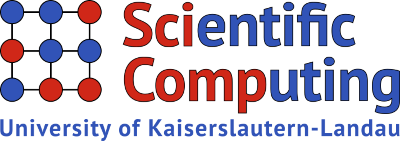Date and Place: Thursdays and hybrid (live in 32-349/online via Zoom). For detailed dates see below!
Content
In the Scientific Computing Seminar we host talks of guests and members of the SciComp team as well as students of mathematics, computer science and engineering. Everybody interested in the topics is welcome.
List of Talks
Event Information:
-
Fri14Jun2019
SC Seminar: Manfred Schneider
11:30SC Seminar Room 32-349
Manfred Schneider, retired senior confirmed advisor Flight-Physics, Airbus Defense & Space Deutschland GmbH
Title:
Noise Simulation at FTEG high-lift airfoil using hybrid RANS/LES ModelAbstract:
This study focuses on the development, validation and application of the interdisciplinary computational fluid dynamics/computational aeroacoustics (CFD/CAA) method with the name Flight-Physics Simulator AEOLus (FPS-AEOLus). FPS-AEOLus is based on enhanced conservative, anisotropic, hybrid Reynolds-averaged Navier-Stokes/ Large-Eddy Simulation (RANS/LES) techniques to solve an aerodynamic flow field by applying the unsteady, compressible, hyperbolic Navier–Stokes equations of second order. The two-layer SSG/LRR-ω differential Reynolds stress turbulence model presented, combining the Launder-Reece-Rodi (LRR) model near walls with the Speziale-Sarkar-Gatski (SSG) model further apart by applying Menter’s blending function F1. Herein, Menter’s baseline ω-equation is exploited for supplying the length scale. Another emphasis is put on the anisotropic description of dissipation at close distance to the solid wall or in wake area for describing the friction-induced surface-roughness behaviour in viscous fluid physics and swirling wake effects. For that purpose, the SSG/LRR-ω seven-equations Reynolds stress turbulence model with anisotropic extension was realized, therefor the theory is described in general. Beyond that, a modified delayed detached-eddy simulation (MDDES) and a scale adaptive simulation (SAS) correction to capture the stochastic character of a large-eddy-type unsteady flow with massive flow separations in the broad band is implemented. To demonstrate the time-dependent noise propagation having wave interference a linearized Euler equation (LEE) model using a combined Momentum- and Lamb-vector source have been applied into the CFD/CAA – method.
The DLR 15 wing, a High-Lift device in landing configuration having a deployed slat and landing flap is studied experimentally and numerically. The first part of the application deals with the steady flow investigation; however, the same turbulence model is used for the unsteady flow case without the enclosed time derivatives. The second part concentrates on unsteady modelling for the Navier–Stokes and Linearized Euler field. With this new combined CFD/CAA – method, steady and unsteady numerical studies for the high-lift wing configuration for discovering the aerodynamic and –acoustic propagation effects are shown, discussed and when experimental data were available validated. The High-Lift wing has a constant sweep angle of Λ=30° to investigate possible cross-flow; to realize this, periodic boundary conditions were set in spanwise direction.
